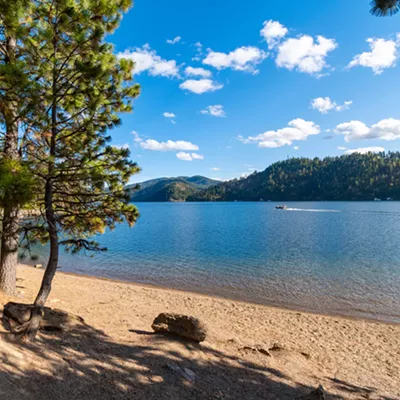Lake Coeur d'Alene is quietly absorbing the cold on these bitter winter days. In days long past, we would hope for ice to cover its entire surface. For the nonce, the lake just lies there looking beautiful, unaware of the dilemma that clouds its future.
High in the headwaters of the Coeur d'Alene River sit the now-defunct mines that once produced billions of dollars worth of silver, lead and zinc. Mines in the Idaho Panhandle's Silver Valley gave forth industrial metals that went into the machines and automobiles that once were the pride of a prosperous nation.
Unfortunately, the metals that enriched all who touched them weren't handled with the care that their toxic nature deserved. Reportedly, 100 million tons of mine waste was swept downstream to cling to the banks of the river and end up in the sediment that lines 160 miles of the Coeur d'Alene and Spokane Rivers and the entire bed of Lake Coeur d'Alene.
Runoff every year spreads more lead, zinc, cadmium and arsenic throughout the flood plain. In flood years, an extra dump of toxins hits the circuit. The Superfund site, in the midst of a cleanup, is one of the largest in the country.
The Environmental Protection Agency has been working over the years, tirelessly and thanklessly, to remove contaminated soils from around homes and businesses in communities including Kellogg, Smelterville, Wardner and Osburn. Recently, the EPA announced that the expanded Central Treatment Plant, along with a groundwater collection system, would capture about 30 percent of the dissolved zinc load from the upper basin.
While we should be thrilled to know that the stream of toxic metals flowing into the Coeur d'Alene Basin will finally be slowed, a note of caution checks the applause.
Zinc, that wily metal, is not only toxic to fish and mammals, its presence in the water has been keeping algae from blossoming in Lake Coeur d'Alene. Zinc's toxic action is seasonally refreshed with the spring runoff.
The quandary staring us in the face is simple but strange: Do we want to keep on polluting the basin with zinc, in order to keep the algae from taking over? Do we fully understand the impact of zinc on the fish we like to catch?
Scientists looking out for the health of the Coeur d'Alene River are also worried by the alarming drop in water quality in the CdA Basin, reflecting heavy timber cutting along the course of the entire drainage.
In fact, a Google Earth time-lapse video shows dramatically that at least one-third of the trees on private land along the river disappeared from the forests between 1984 and 2016. Unfortunately, Idaho's regulations are so lax that the companies responsible are well within their official rights. But overcutting is always more than an unnecessary damn shame.
These scientists, who know a lot more than I do, are concerned that Lake Coeur d'Alene can't take this kind of reckless inattention amid the pummeling of additional phosphorus that it is now enduring.
Lots of questions emerge. Will EPA survive the new Trump administration? If so, will it carry out its plan to expand the Central Treatment Plant, at the heart of the issue in Shoshone County, and install a groundwater collection system to catch the 30 percent of the dissolved zinc load? If not, potential algae blooms in Lake Coeur d'Alene will likely be kept longer in the thrall of the existing zinc loads still coming down the river. Not a very satisfactory solution, but one we could live with.
Will the state environmental steward, the Department of Environmental Quality, keep ignoring the damage to water quality caused by overcutting and not enough surveillance? Will the counties step up to protect the valuable real estate the lakes and rivers represent? Kootenai County, to the contrary, has weakened its setback requirements.
Years ago, when Representative Dean Haagenson was in the Idaho House and I was in the Idaho Senate, we made a joint effort to provide some state protection for our North Idaho lakes. Interest in that concern has long since dissipated. We worried about the lakes being loved to death. Now they are in danger of simple neglect. It takes a combination of federal, state, county and city attention to guard the quality of the water in our lakes, rivers and streams.
I have one bright note to end on: We are fortunate to have the Coeur d'Alene Tribe at the table guiding plans for the restoration of the Coeur d'Alene Basin. It may indeed take a long time, even seven generations, to carry out that restoration. The Coeur d'Alene Tribe is the just and appropriate body to provide the continuity, the wisdom and the caring concern for the land and the water that the task will require. ♦


















